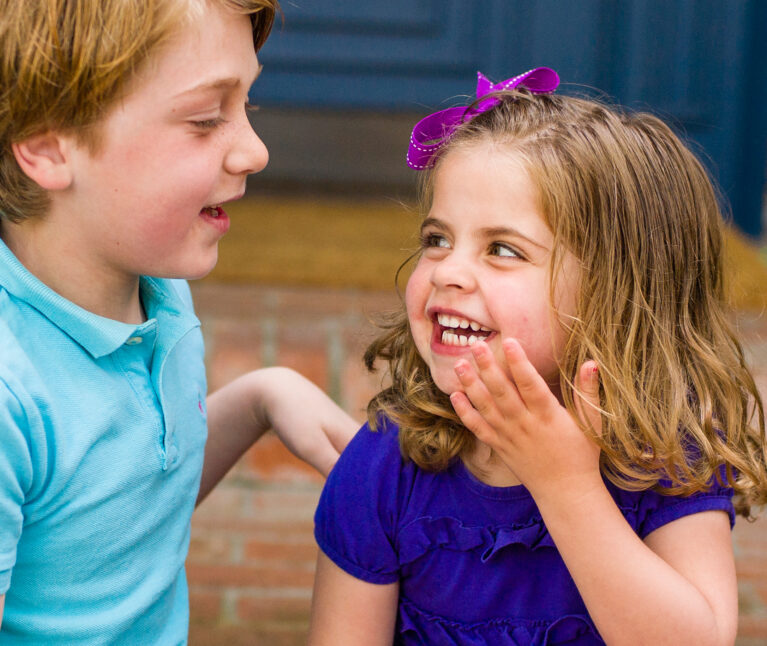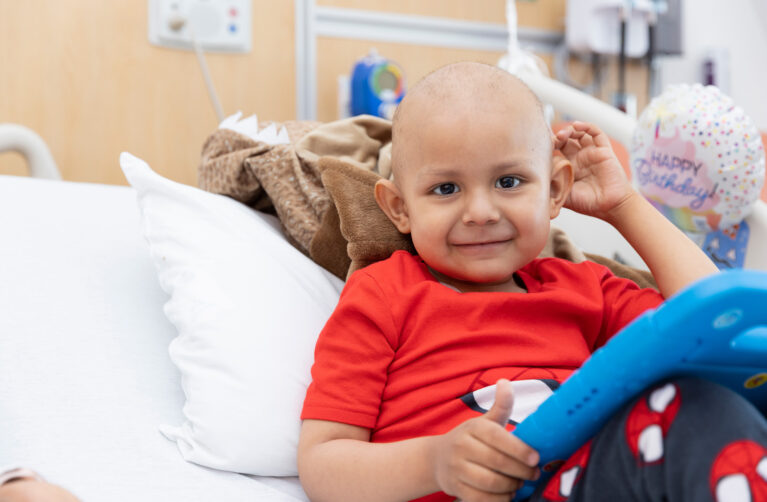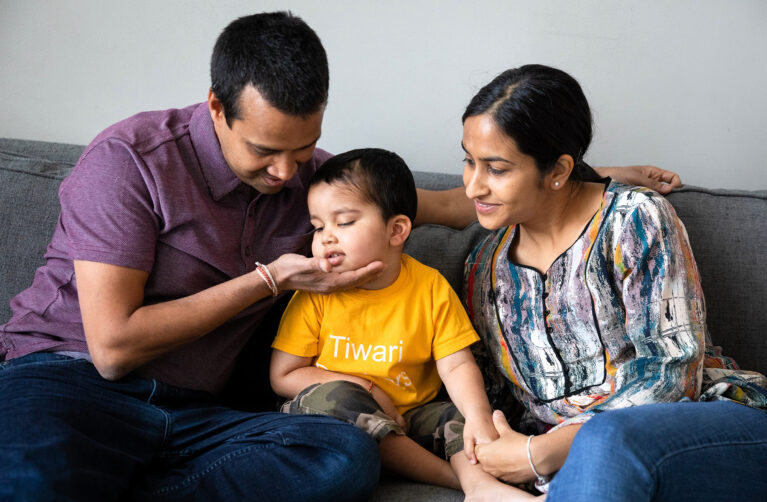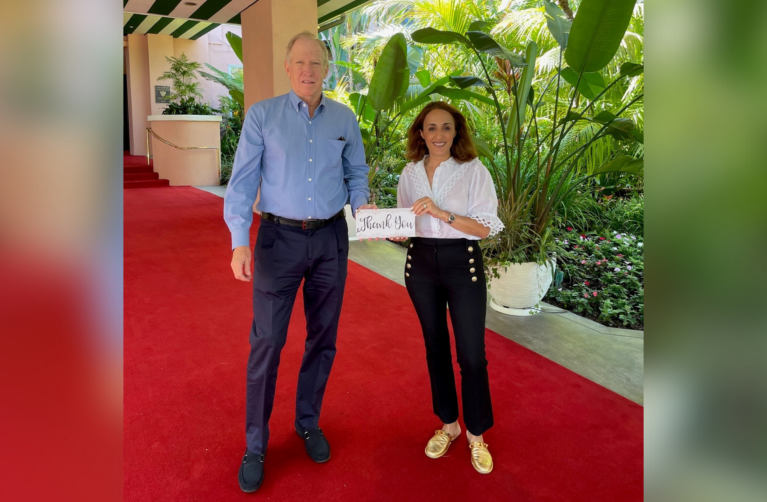Peyton Fisher loves her brother Morgan, wants to be a princess, and decorates her cupcakes with excessive chocolate and marshmallows. In most ways, she is a typical 3-year-old. But for a while, she also had a slight limp — a poignant reminder that just a few months ago, something had gone terribly wrong.
It seemed like just a stomach bug at first. For five days in September 2013, Peyton woke up with nausea but then seemed to get better as the day progressed. When she started to look unsteady on her feet, her parents, Jenna and Colin Fisher, brought her to their local emergency room.
A CT scan showed that Peyton had a tumor four centimeters wide — the size of an egg — in the back of her head. The growth was preventing Peyton’s spinal fluid from draining and was putting pressure on her cerebellum. Without immediate attention, the tumor could grow and cause blindness, stroke, or worse.
Her mother immediately started calling around to find the best place to take her daughter for care.
“Everyone I spoke to said to bring her to Packard,” Jenna recalls. Within two hours, the family was speeding by ambulance to Lucile Packard Children’s Hospital Stanford for Peyton’s emergency brain surgery.
“This was a kid who was never sick,” says Jenna. “It all happened so quickly, we were in shock.”
Emphasizing Quality of Life
Peyton’s family was quickly put at ease. At our hospital, multidisciplinary teams of specialists care for children and adolescents in one of the most advanced surgical facilities in the country. Their medical expertise is partnered with a compassionate approach that focuses on the emotional and psychological aspects of care and the child’s quality of life after treatment.
Peyton was placed in the capable hands of the country’s most dedicated specialists who worked together for seamless delivery of care. Michael S. B. Edwards, MD, chief of pediatric neurosurgery, flew in from his regular clinical outreach rounds in Nevada as soon as his new patient was prepped for her procedure. Throughout the surgery, a nurse gave the worried parents a progress report every 30 minutes.
After eight hours in the operating room, Peyton’s tumor was completely removed by what Jenna calls “a team of the most amazing surgeons ever.” Several days later, another dedicated neurosurgeon, Samuel Cheshier, MD, came into the hospital on a Saturday holiday to happily report that the tumor’s pathology was benign. After 12 days in the hospital, Peyton returned home.
“It wasn’t only that I felt that Peyton was in the most competent hands humanly possible,” Jenna says. “Beyond their technical expertise and excellence, everyone was so empathetic and understanding about how we felt, and they made a point to include us in all decisions about Peyton’s care. They kept us involved every step of the way and were incredibly communicative. I felt like they put themselves in our shoes and genuinely cared about our entire family as human beings.”
A Continuum of Care
For 17-year-old Aria Chimalamarri, surgery is only one of the many types of care our teams have provided to improve her quality of life. Since the age of 5, Aria has experienced numerous seizures, large and small, from a tumor that started small and then came back with a vengeance. Her first surgery was in 2003 at the age of 7, while she and her family were living in India. The tumor quickly grew back, however, and just a few months later Aria underwent a second surgery.
“The seizures were unnerving,” says her mother, Devi Chimalamarri. “She would stop walking or see butterflies that weren’t there. Some would last a few seconds; others would have her thrashing on the ground. They were completely unpredictable — there was something new every time.”
After the second surgery in India, Devi started asking around for advice, unwilling to submit her young daughter to unnecessary surgeries or the long-term side effects of radiation therapy. Once she started talking to experts at Lucile Packard Children’s Hospital Stanford, she was relieved at what she heard — the tumor was less advanced than other specialists had estimated, and Aria would not need another surgery right away. Encouraged by shrinkage in the tumor after two rounds of chemotherapy in India, the Chimalamarri family packed up and moved to San Jose to be close to the specialty care Aria needed at Stanford.
That was eight years ago. Since then, Aria has undergone two more surgeries, a regimen of radiation therapy, and chemotherapy at our hospital. She is now under supervision for seizure management and tumor monitoring.
Despite getting more than her fair share of hospital time, Aria strives to celebrate all aspects of who she is, from her vegan philosophy to her small gold nose ring, which her neurosurgeon was so careful to protect during her last procedure.
“We’ve been through so much, but in retrospect I would still move here. It’s not just the incredible medical treatment Aria gets at Packard Children’s — it’s the whole team. I know we are in good hands. They are always reaching out and including Aria in making decisions,” Devi says.
Holistic Approach to Well-Being
While Aria’s close friends understand what happens to her during a seizure, there are still many misconceptions about epilepsy.
“It’s hard because there’s a lot I can’t do independently,” says Aria, who participates in a monthly support group with other teens. “My friends understand and accept me as I am, even with the seizures. But I want to share information so other people know what it’s like.”
To ease the experience for Aria during her middle school years, specialists from the Hospital Educational Advocacy Liaisons program went to her school to help her classmates and teachers understand her condition. This year, as a high school senior, Aria attended the hospital’s on-site school to avoid having to attend classes in a wheelchair. She also participates in clinics for acupuncture and to learn biofeedback techniques to help manage pain.
“These kids are not treated in isolation,” says Paul Fisher, MD, the Beirne Family Professor of Pediatric Neuro-Oncology and chief of child neurology. “We take a holistic approach to their well-being and connect them to all the resources we have available.”
Aria continues to have regular MRI scans to track any possible recurrence of her tumor and receives ongoing care from specialists in our growing epilepsy clinic, which features the latest tools for diagnosing and treating young patients.
Environment of Expertise
In recent years, new faculty members have been added to increase the breadth and depth of care for more children like Aria and Peyton.
“We already have a great team in place, but now we are building out to expand our expertise and resources,” says Fisher. “We have brought in recruits who have been specially selected to be great clinicians, strong researchers, and national leaders in their respective fields.”
One of these experts is Brenda Porter, MD, associate professor of neurology, who joined the faculty last year to enhance care for children with seizure disorders.
“Epilepsy is not one diagnosis, but many,” says Porter. “There are lots of therapeutic options, but the challenge is to diagnose the disorder correctly and then to identify the best therapy. Our advantage here is that we are in the heart of an academic medical center where the science is the best in the world. It makes it easier for research to translate into clinical care.”
In addition, our specialists are developing and refining innovations like implantable devices, precise imaging technologies, laser surgery, and targeted medication, all designed to be less invasive and improve outcomes for young patients with neurological disorders. With increased scientific insights into human genetics, Porter predicts there will one day be novel treatments that are customized based on the genetic makeup of each patient’s individual disease.
Packard Children’s is also one of only 10 hospitals in the country participating in the Pediatric Brain Tumor Consortium, which is focused on developing new therapies for brain tumors while improving support services and follow-up care.
“There is an environment here that encourages the exchange of expertise, which is the groundwork of a multidisciplinary center of excellence in pediatric neuroscience,” says Gerald Grant, MD, FACS, associate professor of neurosurgery, another recent addition to the team.
“Different disciplines can bridge between our children’s hospital and the adult hospital, and together we can design strategies to help kids not only survive, but to survive well.”
“We have to love the kid more than we hate the disease,” Grant adds. “We need to be aggressive, but cannot push the limit and risk permanent neurological injury that could negatively impact the child’s quality of life.”
Today, Peyton has only six small circles where her hair is still growing in — the marks of the state-of-the-art minimally invasive surgery she received to remove her tumor. She took her first trip to Disneyland in April and enjoys playing with Lucile, the American Girl doll she named in honor of our hospital’s founder.
For the next 10 years, Peyton’s family will continue to visit the hospital on a regular basis for her MRIs and checkups. “Peyton loves to go to the hospital, and we feel very much a part of the community there,” says her father, Colin.
“I remain so impressed with everyone we come in contact with there, including valets, janitors, physical therapists, the medical staff, and more,” says Jenna, who, with her husband, was inspired to make a philanthropic gift supporting our brain tumor research and child life programs. “Their dedication, passion, and excellence in what they do motivate me to push myself harder in whatever contribution I can make to the world. I have so much appreciation and admiration for everyone at Packard Children’s.”
This June, Aria will walk across the stage to receive her high school diploma. While she still has ongoing seizures, those steps mark an especially important transition for her — one that promises a bright future where she can draw, take voice lessons, play with her dog Charlie, and start college in the fall.
“I envision a future for her free of seizures,” her mother says. “But for now we are focused on managing her symptoms and being adaptable. No one wants to be in a hospital, but there’s no other place I would bring her.”



